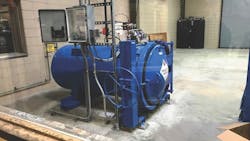Secondary Containment Vessel for Chlorine Gas Cylinders
About the author:
Cliff Lebowitz is an independent reporter and editor for Chlortainer. Lebowitz can be reached at [email protected] or 215.348.5105.
The Erie County (NY) Water Authority used a secondary containment vessel for a chlorine gas cylinder to avoid the need for another scrubber system at the separate-site raw water pump station that serves its 30 mgd conventional surface water treatment plant (SWTP).
The vessel serves the one cylinder in use at the pump station, while a scrubber system serves the eight cylinders inside the plant. Installations similar to the one at the raw-water pump station may be undertaken as part of a switch from liquid chlorination at various booster pump sites in its potable water distribution system.
“It’s been a big help economically to be able to use the containment vessel for the cylinder installation a half mile down the road from the plant,” said a staff representative. “We don’t have the very significant operations and maintenance (O&M) burden there that we have for the scrubber system in the plant. The risk management plan (RMP) says we have to either treat any gas leaks or contain them, and the containment option, which requires very little attention, allows us to avoid time and availability from the two full-time plant operators to regularly maintain another scrubber system, to help assure it will work if needed.”
“Using the containment vessel just requires loading and unloading cylinders and testing the sensors,” he continued. “There’s really not much to it.”
A 1-ton chlorine cylinder is pushed into the secondary containment vessel on rollers. The chlorine transfer hose is attached to the supply valve, pressurized and tested for any leaks at the hose ends. Then the door is closed and secured by the clamshell locking mechanism.
To test for leaks within the containment vessel, there are valved ports that can be opened for testing for chlorine gas. If a leak is discovered within the containment vessel, the operator can withdraw the chlorine gas through a vacuum line that delivers the gas into the treatment process. Thus, chlorine gas leaks are not only contained within the containment vessel, but the gas also can be extracted and delivered via the typical chlorine feed system.
The 1-ton ChlorTainer unit was manufactured by TGO Technologies of Santa Rosa, Calif., and is supplied with loader, scale system and instrumentation.
The Authority’s 30 mgd SWTP, which went online in the 1970s, is joined by a larger plant to serve about 550,000 users in Erie County, excluding the city of Buffalo. Its conventional process includes chemical pretreatment for coagulation and flocculation; sedimentation; filtration; and disinfection.
Chlorine gas is vacuum-fed from 1-ton chlorine cylinders at the separate-site raw water intake to provide for pre-chlorination for zebra mussel control. The 1-ton secondary containment vessel for the gas cylinder was installed November 2018 and started up in December 2018.
The vessels enclose chlorine gas cylinders, the chlorine transfer hose and seismic lock-down brackets.
The chlorine transfer hose is attached to the supply valve, pressurized and tested for any leaks at the hose ends. Then, the door is closed and secured by a clamshell locking mechanism.
Operators switch to the standby containment vessel automatically when the full cylinder runs empty, opening the vacuum breaker valve. The switch-over is performed automatically and does not require personnel to be present.
With any accidental leaks of chlorine kept within the containment vessel, no atmospheric venting is generated. The vessels are ASME-rated pressure tanks, and any leaks are recycled to the injection system at a normal flow rate. A fail safe valve ties into the chlorine leak detection sensor, so that in the event of an external release, the nitrogen fail safe valve will close, stopping it completely.
Any leak or release of chlorine gas from the vacuum line downstream of a vacuum regulator will lose the vacuum condition, and cause the vacuum regulator to close, stopping the flow of chlorine gas to the vacuum line. The maximum release of chlorine gas will be the amount of chlorine gas that is the length of the vacuum line to the chlorine injector and not drawn into the water solution by the suction of the injector.
The vessels’ life expectancy is stated as no less than 100 years, given proper maintenance. This features annually changing out the Viton O-ring on the door, which takes less than about one hour and costs under $200.
In a further commitment to serving the water industry, ChlorTainer partnered with the American Water Works Assn. (AWWA) to financially support aspiring civil and environmental engineers in order to encourage their entry into the industry. For every ChlorTainer sold, the company allocates $1,000 towards their scholarship program. To be eligible of receiving the scholarship, the student must be attending a school in a state corresponding to where a municipality had purchased the ChlorTainer(s) during the year. Further information is available via the AWWA scholarship page.
